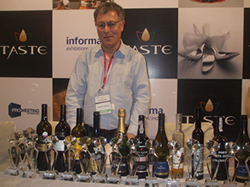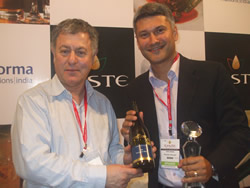 The newly released Barrique Reserve Cabernet Sauvignon 2009 from Four Seasons Winery was adjudged the best Red Indian wine, winning a Bronze. Seagram’s Nine Hills took the Bronze each for their Sauvignon Blanc, Chenin Blanc 2009. Stressing the importance for Rose wine, Robert decided to award the best Rose category, the honours going to the Bronze medalist from chateau d’Ori. Sula’s Viognier 2009 was able to garner a Bronze while the Late Harvest Chenin was the lone silver medal winner. The newly released Barrique Reserve Cabernet Sauvignon 2009 from Four Seasons Winery was adjudged the best Red Indian wine, winning a Bronze. Seagram’s Nine Hills took the Bronze each for their Sauvignon Blanc, Chenin Blanc 2009. Stressing the importance for Rose wine, Robert decided to award the best Rose category, the honours going to the Bronze medalist from chateau d’Ori. Sula’s Viognier 2009 was able to garner a Bronze while the Late Harvest Chenin was the lone silver medal winner.
Robert emphasized that although the Indian wines had been placed under a separated category, they competed against international wines at the same tight level of judging-unlike other competition where they were able to win even Golds with relative ease. ‘It is very important for the Indian industry to realize that the medals have to be earned and not to be given just for participation,’ he said, adding there had been a general all around improvement in Indian wines though there were some poor quality wines as well.
He clarified at the cocktails following the first day of the show that it was important for the Indian producers to learn to face the international competition just like Australia and New Zealand did only about 25 years ago.
The Gold winning Marlborough Sauvignon Saint Claire 2009 was adjudged the best white wine. Lanson came out as the best Champagne and sparkling wine.
At 218 samples submitted, there were a lot less entries this time than last time with India entering around 50. Emphasizing the difference, Robert said a majority of the entries were from the producers outside Indian and were for wines that were not represented in India. With the labels in the market bound to increase with growth of the industry, the awards were more significant in the context of the new entrants. Announcement of results at the show on the first day meant the importers taking part could showcase at the show itself.
 The number submitted was presumably also because the earlier SWIC had a very low entry cost of $40 and there was such a barrage of medals that the importers and producers were scared to enter their wines, knowing the tight standard of judging. There were several exceptions. Vishal Kadakia of The Wine Park whose St. Claire won the best white wine prize was confident enough to have participated despite the great success he has had in SWIC. The number submitted was presumably also because the earlier SWIC had a very low entry cost of $40 and there was such a barrage of medals that the importers and producers were scared to enter their wines, knowing the tight standard of judging. There were several exceptions. Vishal Kadakia of The Wine Park whose St. Claire won the best white wine prize was confident enough to have participated despite the great success he has had in SWIC.
Earlier, Robert Joseph who was conducting the 57th international competition, explained to the 12 judges, who worked throughout the day in 3 panels, that the competition did not follow the OIV system in which no discussions are allowed and the top and bottom scores are discarded, encouraging the tendency in judges to stick to a middle of the course marking encouraging mediocre approach. He encouraged them to discuss if there were any major differences.
The winning wines are available for tasting on 29th and 30th January at the IWC stand.
Subhash Arora
Click Here For India Wine Challenge 2010 Results
Comments: |
|
Yegas Naidoo Says: |
|
The issue is moot but the reality is Indian wines have a long way to come, it is a fledgling industry that will require enormous funding and complete investor dedication but will eventually find its ground in the newly emerging forest of atypical wine making countries - look at England for example - they too are jostling for a place on the map. However let us face it this will not happen in our Generation ! Yegas Naidoo
Yegas
|
|
|
|
| |
|